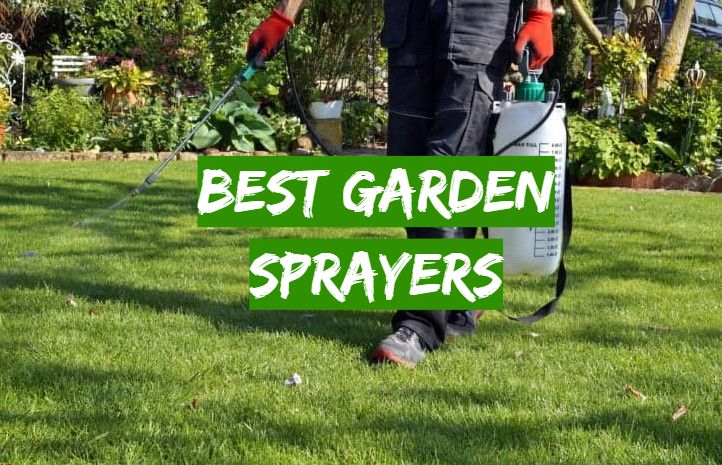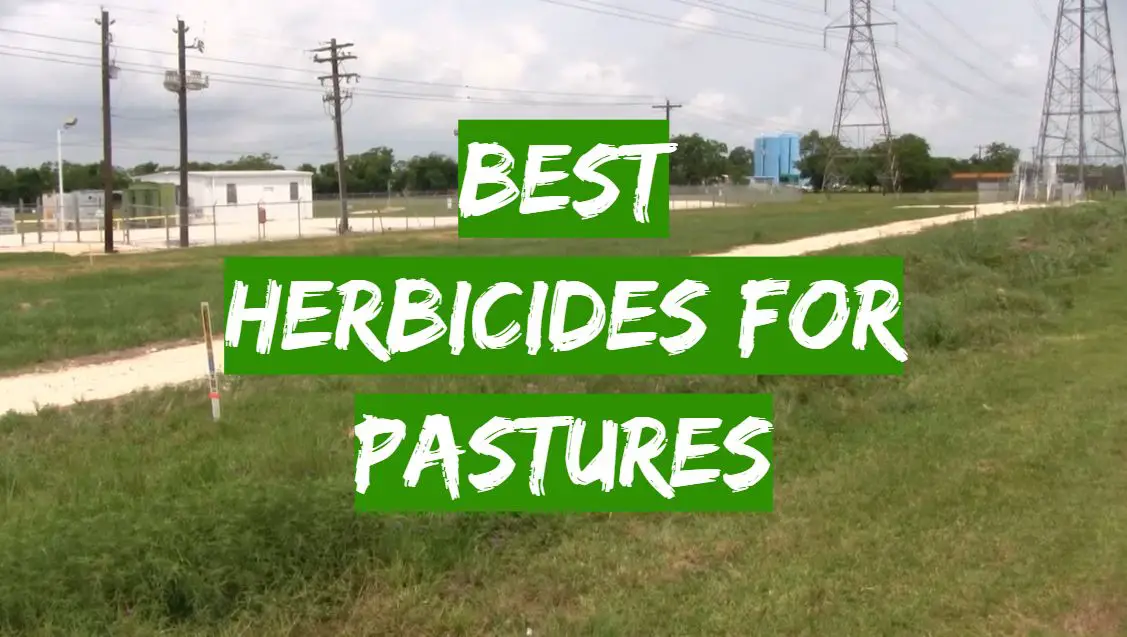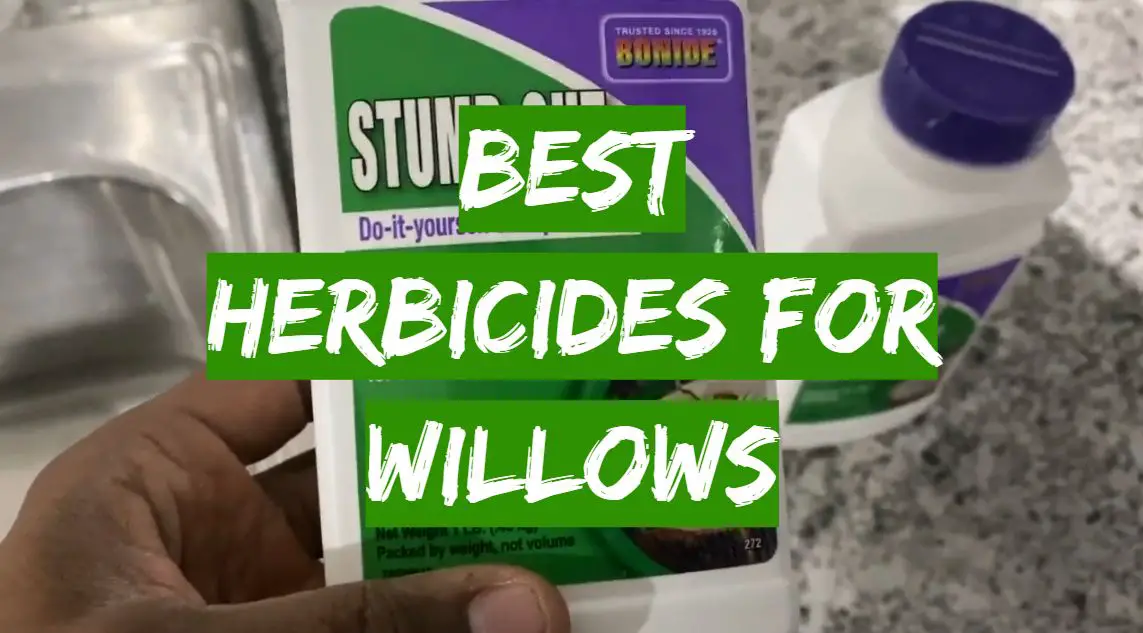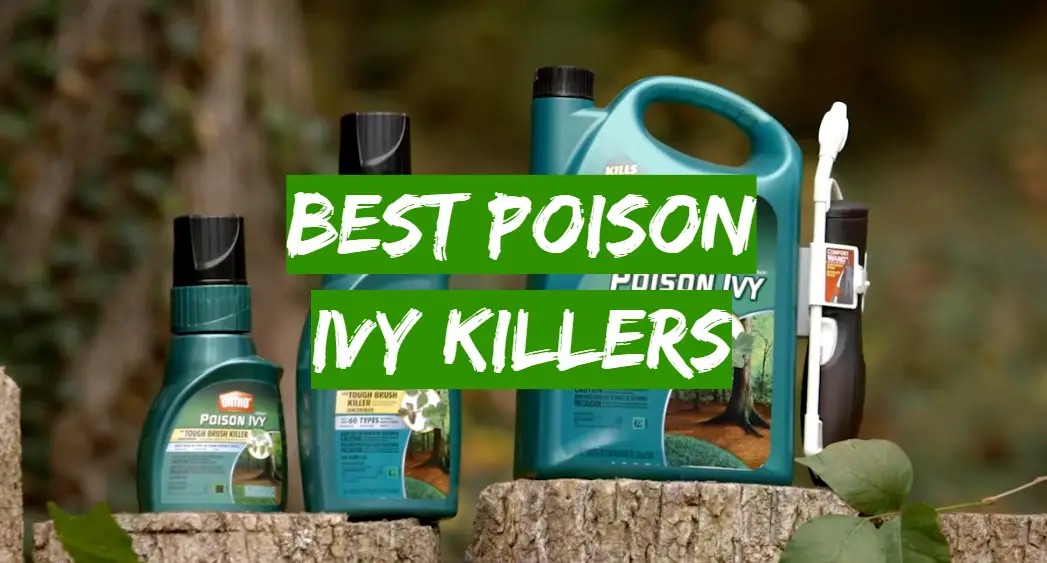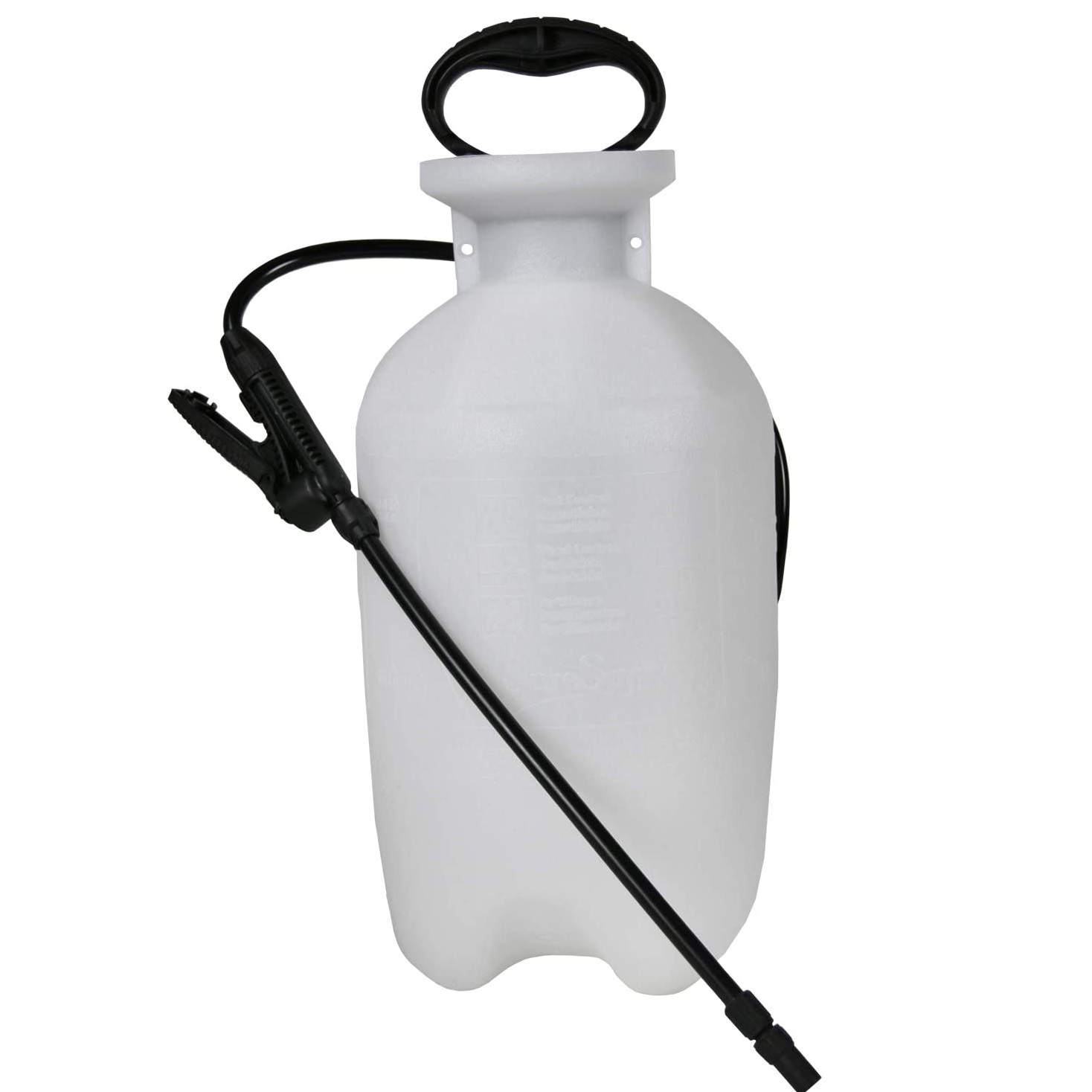
- 2 gallons
- The wand’s length: 12 inch
- Pressure: 40-60 PSI

- 1 gallon
- The wand’s length: 12 inch
- Pressure: 40-60 PSI

- 1 gallon
- The wand’s length: 19 inch
- Pressure: 2.5-3 Bar
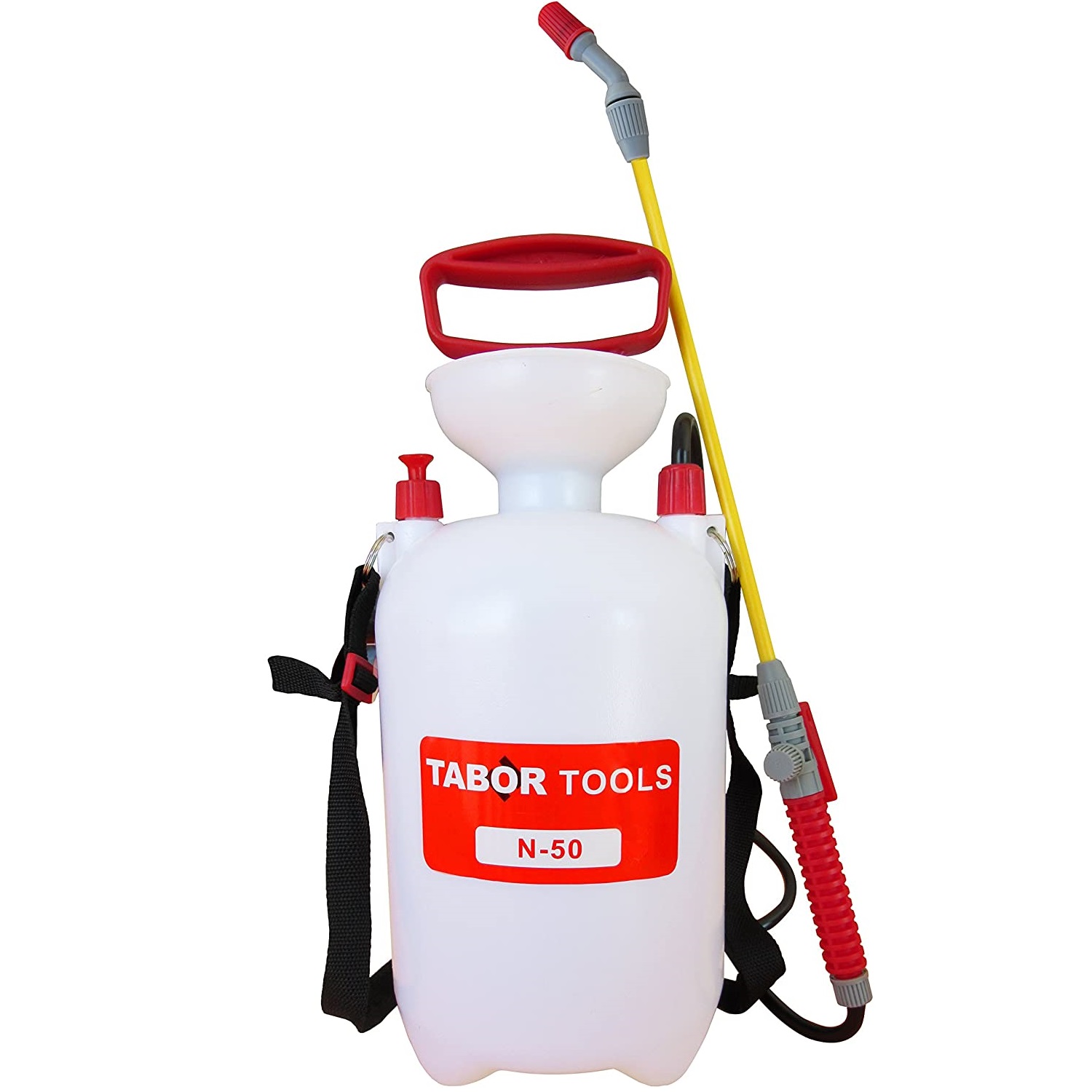
- 1,3 gallons
- The wand’s length: 16,5 inch
- Pressure: 40 PSI
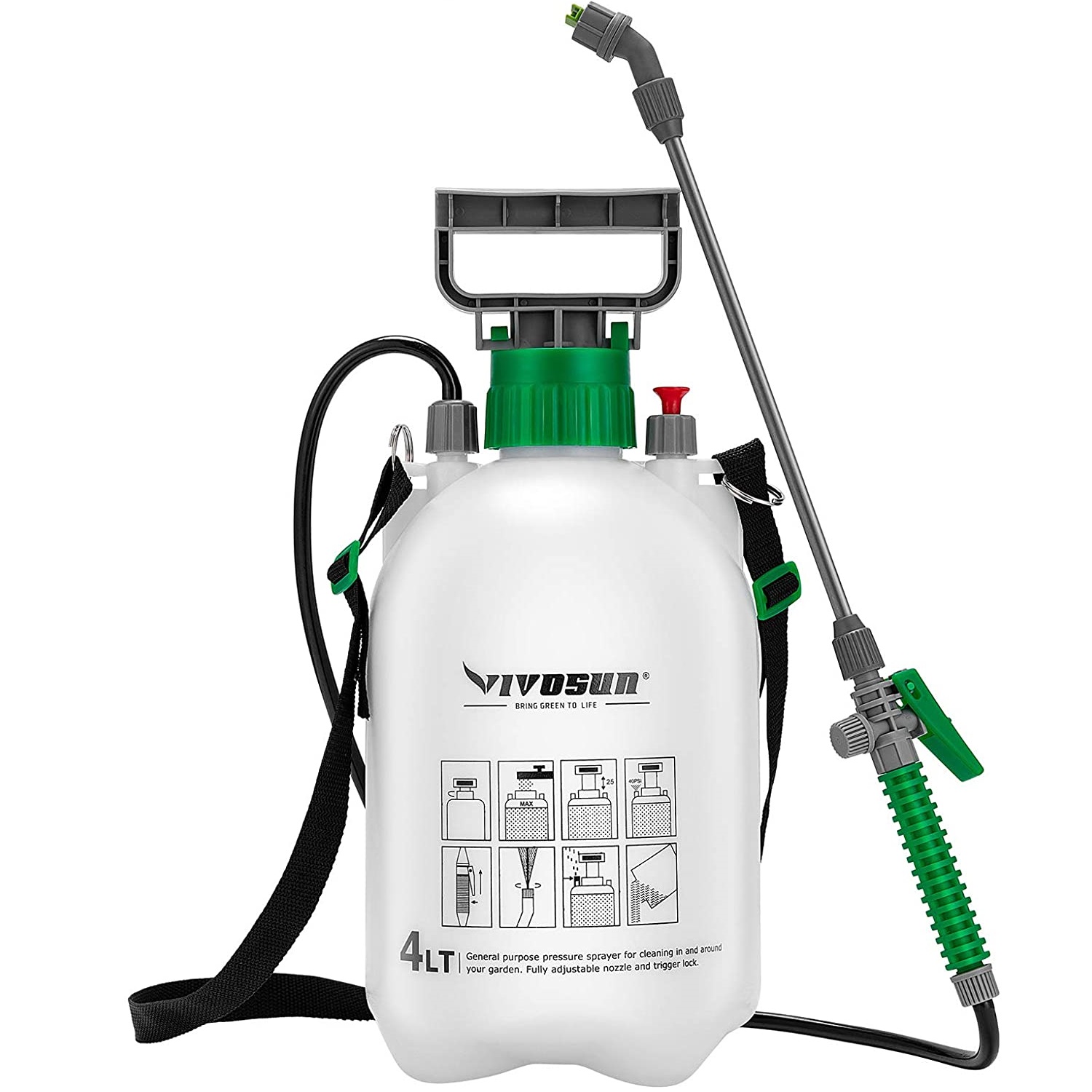
- 1 gallon
- The wand’s length: 22,2 inch
- Pressure: 72.5 PSI
Choose the Best Garden Sprayer
Customer’s Choice: the Best Rated Garden Sprayers
23 users answered this survey. Please help us improve this review!
You won’t have to pay a lot for landscaping services if you use a garden sprayer to keep your plants in good shape. Read on for our best suggestions for garden sprayers that fit any backyard and budget, whether you want to go the simple path and acquire an attachment for a hose or you need something more heavy-duty.
A compression sprayer can help you water your plants fast and conveniently, as well as spray fertilizer, insecticides, and other chemicals across vast portions of your garden or allotment.
These useful garden tools come with a huge container filled with the liquid you’ll be spraying on your plants. A pump handle is used to pressurize the container, and the associated lance and nozzle are then applied to spray or mist the liquid. This will increase the coverage area and make it simpler to reach plants on all levels.
Herbicides, fungicides, and pesticides can all be purchased in bulk with a garden sprayer, saving you money and reducing the amount of plastic trash produced. Remember that you won’t want to apply the identical sprayer for fertilizers and pesticides, so you’ll probably need more than one.
Reasons to use garden sprayers:
- Cost-effective;
- Versatile – spray anything liquid: from water to weed killers;
- Adjustable nozzles;
- Easier to use than garden hoses;
- Portable;
- Good for spot spraying separate bushes and leaves;
Those garden hobbyists and experts who need reliable sprayers should definitely read till the end. The product reviews of the best garden sprayers and comparison table can be very helpful.
Table of Contents
CHAPIN 20002 2-Gallon Lawn Sprayer – the best for the volume!
 This Chapin sprayer is reasonably priced and does the job well. In your garden, you may use it to spray insecticides, pesticides, or any kind of liquid fertilizer.
This Chapin sprayer is reasonably priced and does the job well. In your garden, you may use it to spray insecticides, pesticides, or any kind of liquid fertilizer.
The anti-clog filter keeps clogs at bay. It produces a long-lasting spray that doesn’t pause or stop. You can see how much and where you’re spraying with the adjustable foaming nozzle. Foam is built up faster when the nozzle has longer and greater surface contact with the plants.
With a simple twist of the cone nozzle, you may vary the spray from a drizzle to a coarse stream. You can achieve pressures of 40-60 PSI, allowing you to stream up to 25 ft. It’s simple to use and clean thanks to the piston-based pump.
It is available in a variety of tank sizes ranging from one gallon to three gallons. A 12-inch wand, a 28-inch robust hose, an adjustable nozzle, and a spray handle are included in the package. While spraying, the durable pump handle gives a secure grip.
CHAPIN 20000 Garden Sprayer – the best for the in-tank filter!
 For weed control, insect control, and fertilizer applications, the Chapin 1-gallon sprayer can be an excellent choice. It has Chapin’s patented in-tank anti-clog filter, which ensures a clog-free, consistent spray.
For weed control, insect control, and fertilizer applications, the Chapin 1-gallon sprayer can be an excellent choice. It has Chapin’s patented in-tank anti-clog filter, which ensures a clog-free, consistent spray.
Pumping and transporting are made easier with an ergonomic pump handle. The transparent, compact, rust-free poly tank makes checking fluid levels simple.
The Chapin sprayer excels in narrowing the gap between commercial and home applications. To begin with, its 1.3-gallon size makes it pretty simple to transport; it even includes shoulder straps.
There is no need to be concerned about maintenance; nevertheless, since the nozzle is plastic, washing it with vinegar occasionally is required; it will get blocked by a scale from the water.
The spray system has a high degree of dependability. While this gadget lacks extra nozzles, the diagram printed on its body performs an excellent job of assisting you in keeping track of the chemical levels.
ITISLL Portable Garden Pump Sprayer – the best for the shoulder straps!
 This ITISLL sprayer is a multi-function, handheld, portable model. This model’s primary purpose is to water plants, but it may also be used to bathe pets and clean the house.
This ITISLL sprayer is a multi-function, handheld, portable model. This model’s primary purpose is to water plants, but it may also be used to bathe pets and clean the house.
With its top-of-the-line brass nozzle, you can effortlessly switch from one level of intensity to another. You have the option of a fine mist spray or a fine injection. The 50-inch hose, along with the strong 19-inch spray, allows you to wash difficult-to-reach regions with no effort.
Because the handle is at the top, this type is meant to decrease tension and strain. Furthermore, the device has a shoulder strap that allows the gardener to move more freely while also distributing the tank’s weight.
Because it is made of top-of-the-line PE material, this sprayer is very durable. The transparent container is quite useful since it serves as a gauge for the amount of liquid within.
TABOR TOOLS Pump Pressure Sprayer – the best for spraying hot liquids!
 With its angled sprayer extension, the Taber Tools sprayer is ideal for rapid garden spraying. This makes it suitable for both indoor and outdoor usage. You can look inside the container and monitor the fluid level thanks to the transparent bottle design.
With its angled sprayer extension, the Taber Tools sprayer is ideal for rapid garden spraying. This makes it suitable for both indoor and outdoor usage. You can look inside the container and monitor the fluid level thanks to the transparent bottle design.
This device may also be used to spray water up to 131 degrees Fahrenheit and moderate pest control chemicals without the need for solvents (PH range 5-8).
The funnel’s broad opening enables simple filling without spilling. There are no tools necessary since all you have to do is remove the top cap, fill it up, and get ready to spray. Its multi-purpose carrying construction enables you to sling it on your shoulder or hold it vertically from the top.
The revolutionary design shut-off valve on the comfort-grip handle enables you to relax your hand while maintaining a consistent flow. It is available in a variety of capacities, ranging from a 0.3-gallon handheld sprayer to a 2-gallon pump sprayer. Depending on your requirements, you’ll have a wide range of options to pick from.
The Tabor Tools Sprayer is a good choice for a small yard or even indoor use. It’s small, portable, and comes with a pressure relief valve for easier release.
VIVOSUN 1-Gallon Pump Pressure Sprayer – the best for nozzles!
 The fact that this super pump sprayer includes a pressure relief valve is a crucial factor in its drive. The Vivosun device has adjustable shoulder straps that improve the user experience. It is the most recommended device for most outdoor and indoor jobs because of its large capacity of 1 gallon.
The fact that this super pump sprayer includes a pressure relief valve is a crucial factor in its drive. The Vivosun device has adjustable shoulder straps that improve the user experience. It is the most recommended device for most outdoor and indoor jobs because of its large capacity of 1 gallon.
Furthermore, its high-pressure pump sprayer (60-70 PSI) delivers herbicide quickly and efficiently. Because the pump is made of high-quality materials, it will never interact with chemicals. There is no tension while using the equipment since it is designed to be used with only one hand and has an adjustable nozzle.
It’s easy to add chemicals or water to the pump. Remove the top and pour the solution into the funnel’s extra-wide mouth. Replace the top and you’re ready to garden. This method is also effective for other spraying applications, such as insect control.
This type is an excellent introduction to battery-powered sprayers and makes spraying a breeze.
This basic instrument makes spraying straightforward and enjoyable. This water sprayer is operated by a handheld pump. It raises the device’s pressure before activating the spray. You can effortlessly spray hard-to-reach locations with an extra-long 22.2-inch wand.The Buyer’s Guide
Types of garden sprayers:
1) Battery or gasoline-powered devices
These sprayers utilize gasoline or a battery as a power source to eject the solution instead of relying on a pump to produce pressure. These sprayers are very adaptable, and they may simply be outfitted with spray nozzles and garden hoses.
These devices can contain more liquid, but they are also more costly than their non-powered rival models.
2) Compression (pump action) sprayers
This pressure differential inside the canister of a pump-action sprayer determines how much of a chemical liquid you’ll receive while spraying your garden. The solution should come out with less power if there is too much air in such a sprayer.
Pump-action spraying gardeners must evacuate the air using a pump to avoid the buildup of oxygen. When compared to a powered device, this sort of sprayer is quite inexpensive. Generally speaking, they are excellent for fast chores that need some flexibility.
3) Backpack sprayers
This kind of sprayer is great for people with arthritis or for those users who want to carry a considerable quantity of the solution on the backs instead of their arms. Many backpack-style sprayers include a pump-action system, however, the pump in these models is normally operated by a lever.
You won’t be able to get in close beneath the leaves with this model, but it’s one of your finest alternatives for thorough spraying of vast gardens.
4) Handheld sprayers
Handheld sprayers usually have two ports: one for the hose and one for the solution. Simply plug the hose into the backport and use it for spraying your garden. Just pull the trigger once it’s attached, and you’ll get a mixture of the solution, water, and, ideally, a spreader sticker to apply to your perennials.
Some handheld sprayers even allow you to measure out the quantity of solution you wish to apply per 1 gallon of water, which is quite useful for keeping track of your mixture.
5) Wheeled sprayers
These are simple to transport and are great if you suffer from arthritis or back issues that prevent you from moving large objects. Just wheel a sprayer to the garden and spray away; but, since this model is less maneuverable, use a more portable alternative if you need to reach low beneath a leaf.
Tank capacity
A bigger tank means your sprayer will be bulkier to transport throughout your garden, which is a crucial factor for any sprayer user. Large tanks larger than 3-gallons, except for wheeled models, will be difficult to use without first putting them down.
When selecting a garden sprayer, keep this in mind; you don’t want a device that will weigh you down. A greater tank capacity, on the other hand, means you’ll have to refill it less often.
Sprayer tanks come in a variety of sizes, ranging from one tank to more than three gallons. Handheld sprayers have the lowest capacity, while backpack sprayers have the greatest, however, backpack sprayers come in lower sizes as well.
Tank capacity is determined by the size of a garden. If you have a large garden, a sprayer with a large capacity is recommended.
Materials
Garden sprayers are often made of polyethylene plastic, stainless steel, or galvanized steel. Plastic is the lightest and cheapest material, but it’s less durable than steel. Steel sprayers, on the other hand, are bulkier but more robust. Frequently, plastic will suffice as a non-powered sprayer’s material. If you don’t use it in the “regular” manner, such a sprayer may survive for years.
Nozzles
It’s critical to think about the nozzles that will be included with your garden sprayer. Having additional nozzles allows you to get the most out of the purchase by allowing you to do more jobs. On the other hand, it is inefficient to waste cash on a nozzle type that you do not need.
The area that a nozzle can reach in a single pass is the most significant distinction between them.
Garden sprayers with various nozzles normally come with 3-4 choices, the most common of which is a very thin and straight nozzle. This model in particular can be great for spraying pesticides on weeds.
Another sort of nozzle that comes standard with most types is the one that covers a large area. This is a good one to use for insecticides, particularly if you have a big lawn or a farm.
Then there’s also the nozzle type that isn’t as broad or as thin as the other two models, allowing you to use it for normal garden duties.
Cleaning
Cleansing the sprayer after each usage is necessary to remove any slugs that have accumulated in the nozzle or the tank. This is especially true if you’ve used a harmful weed killer and don’t want your children or pets to come into touch with it.
Maintenance is relatively simple for most sprayers since they are cleaned after each use by filling them with soapy water. Then shake the tank to distribute the soap evenly and let it work for 10-15 min. Then, using normal water, rinse the container and clean the nozzle.
Cleaning certain tiny nozzles may need the use of extra instruments. These tools will be included with the garden sprayer unit. Keep it secure and don’t let it go missing. You’ll have to purchase it individually if you don’t have it. Follow the manufacturer’s cleaning instructions if there are any.
FAQ
What are the benefits of using a garden sprayer?
There are many benefits to using a garden sprayer, but the most important one is that it can help you save time and effort. Instead of having to manually apply herbicides or pesticides with a brush, you can simply attach your garden hose to the sprayer and cover a larger area in a fraction of the time.
Another benefit of using a garden sprayer is that it can help you apply chemicals more evenly, which means they’ll be more effective. And if you’re using herbicides or pesticides, a garden sprayer can also help you avoid contact with the chemicals, which is important for your safety.
What types of plants can you use a garden sprayer on?
Garden sprayers come in a variety of forms and sizes, but not all are made equal. You need to make sure you choose the right garden sprayer for your needs before making a purchase.
The first step is to figure out what sort of plants you’ll be spraying with the garden sprayer. If you plan on using it on delicate plants, then you’ll need to choose a garden sprayer that has a soft spray. If you plan on using it on tougher plants, then you can choose a garden sprayer with a stronger spray.
Once you know what type of plants you’ll be using the garden sprayer on, then you can start looking at different models. There are all sorts of different garden sprayers on the market, so it’s important to do your research before making a purchase.
What should you consider when purchasing a garden sprayer?
When you’re looking for a new garden sprayer, there are a few things you’ll want to keep in mind. First, think about the size of your garden. If you have a large space to cover, you’ll need a larger capacity tank. You’ll also want to consider the type of nozzle that’s best for your needs. There are a variety of nozzles available, each designed for different tasks.
Next, think about the type of plants you’ll be spraying. Some garden sprayers come with adjustable settings that allow you to change the flow rate and pressure, which is ideal for delicate plants. If you have a lot of tough weeds to tackle, look for a garden sprayer with a higher flow rate.
Finally, think about how often you’ll be using your garden sprayer. If you only need it occasionally, a battery-powered model might be the best option. For more frequent use, an electric garden sprayer will be more powerful and easier to use.
What are some tips for using a garden sprayer?
Garden sprayers come in all shapes and sizes, so it’s important to choose the right one for your needs. The most important factor to consider is the size of your garden. If you have a small garden, you can get away with a hand-held or small pump sprayer. But if you have a large garden, you’ll need a bigger pump sprayer or even a tow-behind model.
Another important factor to consider is the type of plants you’re spraying. If you’re just trying to keep the weeds down, you won’t need a very strong sprayer. But if you’re trying to kill insects or fungus, you’ll need something that can generate a more powerful spray.
Finally, you’ll need to think about the nozzle. Some nozzles are better for different types of spraying. So, make sure to choose a nozzle that will work well with the type of spraying you’ll be doing.
What are the three main garden sprayers?
The three main types of garden sprayers are: pump, hose-end, and backpack. Each has its own advantages and disadvantages that you should consider before making a purchase.
Garden pump sprayers are a gunmen of sorts – being able to take on various jobs such as watering your plants or applying pesticides. They are easy to use and can be adjusted to deliver a variety of spray patterns.
Hose-end sprayers are the easiest type of garden sprayer to use, but they are not as versatile as pump sprayers. They are best suited for small jobs, such as watering potted plants or applying herbicides to a small area.
Backpack sprayers are the most labor-intensive type of garden sprayer, but they are also the most versatile. They can be used for a variety of tasks, from watering plants to applying pesticides. Backpack sprayers are ideal for large jobs, such as applying herbicides to a large area.
Who makes the best garden sprayer?
There are a few companies that make garden sprayers and each has their own set of pros and cons. Some people prefer one brand over another for personal reasons, but there are objective factors to consider as well. Below, we’ll take a look at three of the most popular brands and see how they compare.
Are cheap garden sprayers any good?
The answer to this question is a resounding no. Cheap garden sprayers are not only ineffective, but they can also be dangerous. In addition, cheap garden sprayers often break easily and can end up costing you more in the long run.
Instead of opting for a cheap garden sprayer, it is best to invest in a quality product that will last you for many years to come. In this guide, we will help you choose the best garden sprayer for your needs.
Can a beginner use a garden sprayer?
Yes, garden sprayers are relatively simple to use. You will need to read the user manual for your specific model in order to understand how to operate it properly and safely. Generally, you will fill the tank with your chosen liquid, pump it up using the handle, and then pull the trigger to release the spray.
There are a few things to keep in mind when using a garden sprayer. First, you will want to make sure that you are wearing appropriate clothing and safety gear, such as gloves and a mask. Second, you will want to be careful not to over-spray the area, as this can damage plants. Finally, you will want to clean your garden sprayer thoroughly after each use to prevent clogs and build-up.
How much does a good garden sprayer cost?
The average cost of a garden sprayer is about $30. However, there are some higher-end models that can cost up to $200. If you plan on using your garden sprayer for large projects or professional use, it is worth investing in a more expensive model. Otherwise, a cheaper model will suffice.
How long do garden sprayers last?
Garden sprayers can last anywhere from a few years to several decades, depending on the model and how well it’s maintained. Higher-quality models with proper care can last much longer than cheaper ones.
To get the most out of your garden sprayer, it’s important to choose the right model for your needs and to follow the manufacturer’s instructions for proper care and maintenance. You may use a garden sprayer for many years without any problems.
Useful Video: Top 7 Best Garden Sprayers
Final thoughts
That’s all there is to it. For your convenience, garden experts evaluated some of the top garden sprayers. Hopefully, the guide assisted your selection and you’ve liked reading these product reviews.

